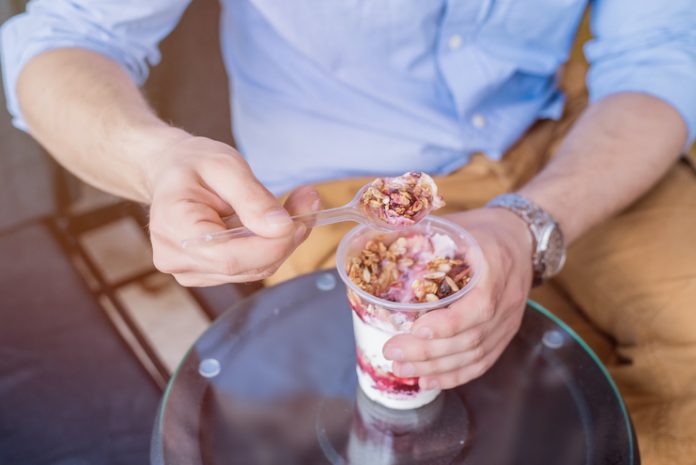Even before the onset of COVID-19, the hotel industry witnessed the rise of grab-and-go food and beverage offerings in lobby marketplaces, breakfast areas, and onsite cafes. But as the pandemic halted travel, causing occupancy to drop and properties to reduce staff and limit operations, pre-packaged food became a necessary staple for many hotels that did remain open to guests. In addition to reducing contact between guests and staff and ensuring the health and safety of everyone on property, grab-and-go-style F&B allows hotels to cater to a range of dietary preferences—from the shift towards healthier eating to increased demand for plant-based options.
Don Falgoust, vice president of F&B execution and strategy at Remington Hotels, returned to the management company this year amid the COVID-19 outbreak after 15 years working with an ownership group. Seven weeks into his new role, Falgoust told LODGING that while Remington’s hotels remained open as essential businesses throughout the pandemic, most properties have been forced to operate with skeleton crews and virtually no food and beverage staff. “The pandemic dictated the closure of F&B offerings,” Falgoust said. “It was not only from an economic standpoint—which was pretty much a no-brainer—but also [in response to] government and local mandates.”
However, Falgoust added, local restrictions also meant that guests didn’t have many dining options outside hotel properties either. “We saw a need to provide a form of F&B service to our guests because you couldn’t just leave your hotel and go down the street to a free-standing restaurant—they were all shut down as well. They could go to a grocery store, but that really wasn’t convenient,” he explained.
The solution was to provide food that guests could retrieve with minimal exposure to hotel staff and take back to their rooms. Falgoust said that hotels like Embassy Suites that traditionally served complimentary breakfast moved to “a self-contained breakfast grab-and-go offering available at the front desk and delivered in a touchless fashion.”
The situation has also prompted Falgoust to reimagine Remington’s Corner Pantry markets to meet guests’ evolving needs, adding more packaged meals such as healthy sandwiches, salads, and grain bowls in addition to the candy, chips, and other snack foods and sundries that the pantries traditionally stocked. “It really provides a much wider bandwidth of products to better address people who need a meal facsimile, and it can complement any dietary restrictions that guests may have.” Falgoust added that Remington is focused on sourcing high-quality products that are “ingredient-driven” and meet guests’ dietary needs.
Offering a variety of pre-packaged options in a grab-and-go format—from yogurt to plant-based snacks—satisfies precisely what travelers are looking for today—a “hermetically sealed environment,” as Dana Pellicano—vice president of F&B experience for Marriott International, the Americas—puts it. “People want endorsed brands. They want packages—things that are sealed. It’s a sign of comfort,” she explained. “We’re seeing that shift irrespective of COVID; we were seeing it pre-COVID, but now we’re seeing it intensified.”
Some of the largest marketplaces in Marriott’s portfolio—like those of Orlando World Center Marriott and Sheraton San Diego Hotel & Marina—operate in a to-go style, Pellicano added. “Their volume has increased tremendously because people want to look and see an array of things that are individually packaged and portioned that they can take with them.”
Pellicano said that this trend has been a long time in the making. She cited a 2015 study from Marriott, which found that while 42 percent of guests felt comfortable eating in their rooms, only 14 percent were eating food from the property. “We saw that not just in the numbers—our housekeepers said that they saw it,” Pellicano explained. “Even as long as five years ago, people were saying, ‘Look, we want to eat differently. We don’t necessarily always want a sit-down meal, and we don’t necessarily want your room service.’”
The types of food guests want to eat during their stay has changed as well. Pellicano shared that when her mother was a “road warrior,” “It wasn’t breakfast if there weren’t hot eggs and bacon.” Today, however, we are living in “the age of yogurt and hummus,” Pellicano said, and travelers are making fresher and lighter choices. “People are comfortable having salads, sandwiches, and wraps that have been made in advance, particularly those that tend to be healthier,” she said, adding that meatless options and those with a longer shelf life are a particular focus. “We’re seeing those items really fly off the shelf.”
The current environment has underscored the importance of positioning hotels for the future. Pellicano said that COVID-19 has “magnified” the need for hoteliers to invest in areas like mobile dining through which guests can place orders using an app. “We’ve been running around talking about how food delivery, takeout, and grab and go was a $20 billion industry in 2019 and how 50 percent of orders globally are being placed using apps and delivery services,” Pellicano said. “But nothing really drove that point home quite like the pandemic.”











